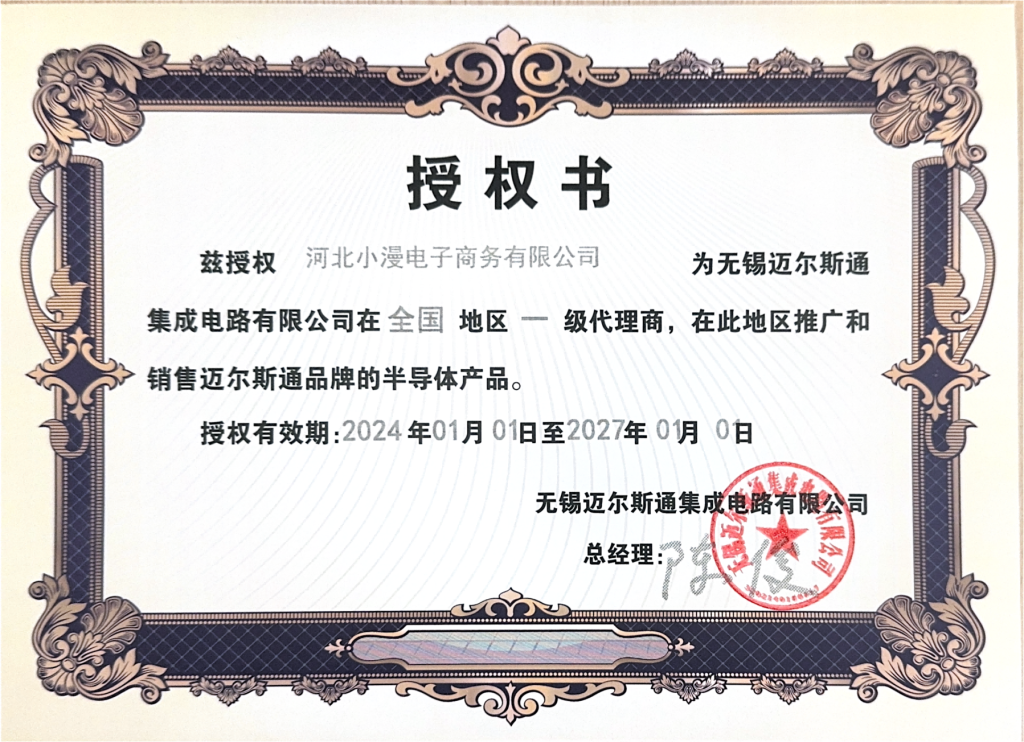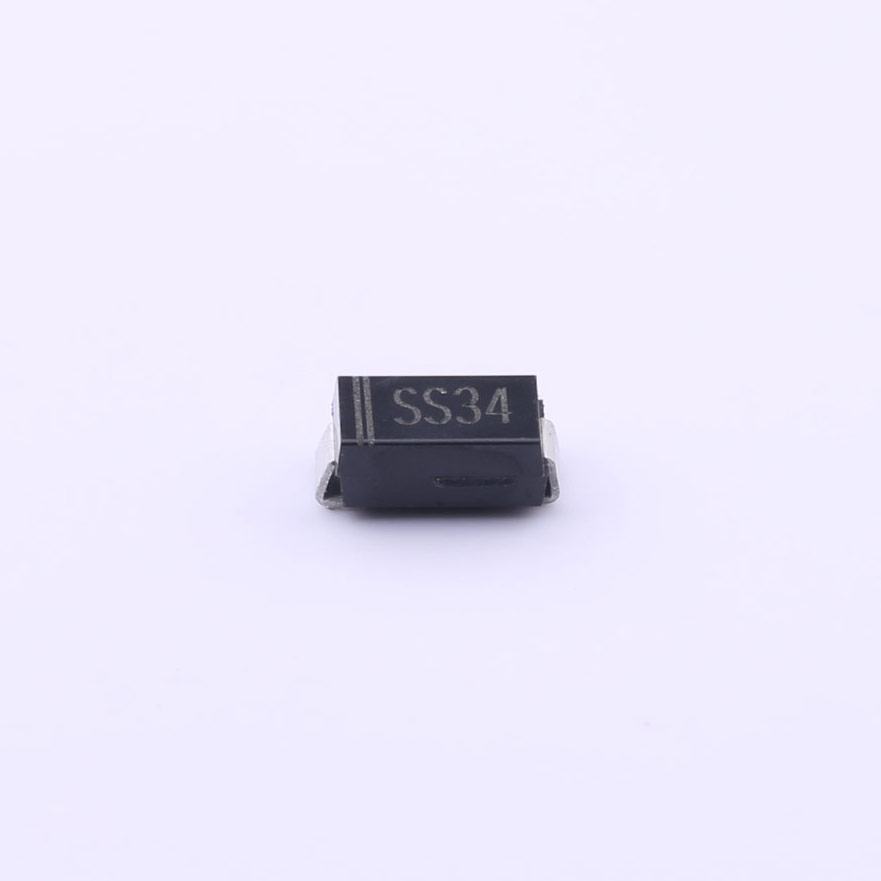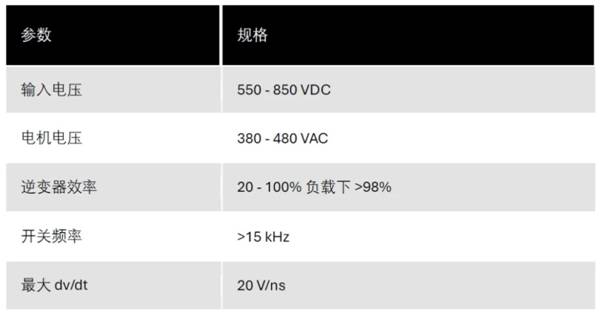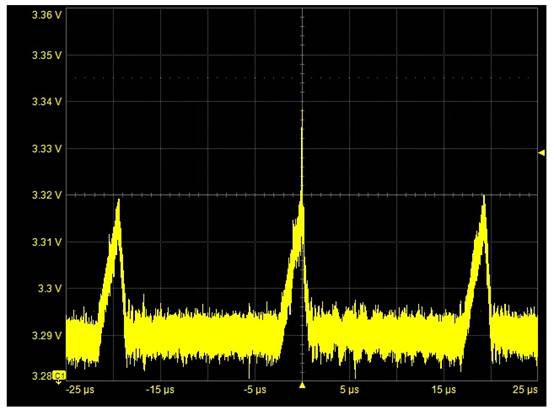众所周知,机器学习能够大体分为三大类:监督学习、非监督学习和半监督学习。监督学习能够认为是咱们有十分多的labeled标示数据来train一个模型,等待这个模型能学习到数据的散布,以期对未来没有见到的样本做猜测。那这个功能的源头–练习数据,就显得十分感觉。你有必要有满足的练习数据,以掩盖真实实践数据中的样本散布才能够,这样学习到的模型才有含义。那非监督学习便是没有任何的labeled数据,便是平常所说的聚类了,使用他们自身的数据散布,给他们区分类别。而半监督学习,望文生义便是处于两者之间的,只要少数的labeled数据,咱们企图从这少数的labeled数据和许多的unlabeled数据中学习到有用的信息。
一、半监督学习
半监督学习(Semi-supervised learning)发挥作用的场合是:你的数据有一些有label,一些没有。并且一般是绝大部分都没有,只要少量几个有label。半监督学习算法会充沛的使用unlabeled数据来捕捉咱们整个数据的潜在散布。它根据三大假定:
1)Smoothness滑润假定:类似的数据具有相同的label。
2)Cluster聚类假定:处于同一个聚类下的数据具有相同label。
3)Manifold流形假定:处于同一流形结构下的数据具有相同label。
例如下图,只要两个labeled数据,假设直接用他们来练习一个分类器,例如LR或许SVM,那么学出来的分类面便是左图那样的。假设实践中,这个数据是右图那儿散布的话,猪都看得出来,左图练习的这个分类器烂的乌烟瘴气、不忍目睹。由于咱们的labeled练习数据太少了,都没办法掩盖咱们未来或许遇到的状况。可是,假设右图那样,把许多的unlabeled数据(黑色的)都考虑进来,有个全局观念,牛逼的算法会发现,哎哟,原来是两个圈圈(别离处于两个圆形的流形之上)!那算法就很聪明,把大圈的数据都归类为赤色类别,把内圈的数据都归类为蓝色类别。由于,实践中,labeled数据是贵重,很难取得的,但unlabeled数据就不是了,写个脚本在网上爬就能够了,因而假设能充沛使用许多的unlabeled数据来辅佐提高咱们的模型学习,这个价值就十分大。
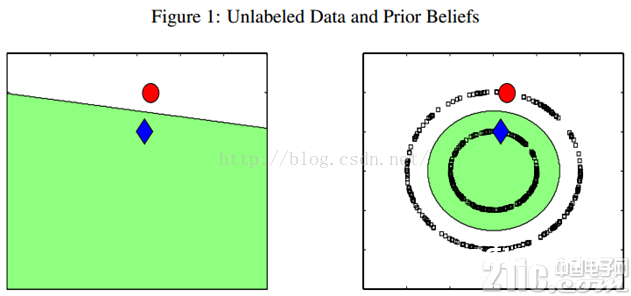
半监督学习算法有许多,下面咱们介绍最简略的标签传达算法(label propagation),最喜欢简略了,哈哈。
二、标签传达算法
标签传达算法(label propagation)的中心思维十分简略:类似的数据应该具有相同的label。LP算法包括两大进程:1)结构类似矩阵;2)英勇的传达吧。
2.1、类似矩阵构建
LP算法是根据Graph的,因而咱们需求先构建一个图。咱们为一切的数据构建一个图,图的节点便是一个数据点,包括labeled和unlabeled的数据。节点i和节点j的边表明他们的类似度。这个图的构建办法有许多,这儿咱们假定这个图是全衔接的,节点i和节点j的边权重为:

这儿,α是超参。
还有个十分常用的图构建办法是knn图,也便是只保存每个节点的k近邻权重,其他的为0,也便是不存在边,因而是稀少的类似矩阵。
2.2、LP算法
标签传达算法十分简略:经过节点之间的边传达label。边的权重越大,表明两个节点越类似,那么label越简略传达曩昔。咱们界说一个NxN的概率搬运矩阵P:

Pij表明从节点i搬运到节点j的概率。假定有C个类和L个labeled样本,咱们界说一个LxC的label矩阵YL,第i行表明第i个样本的标签指示向量,即假设第i个样本的类别是j,那么该行的第j个元素为1,其他为0。相同,咱们也给U个unlabeled样本一个UxC的label矩阵YU。把他们兼并,咱们得到一个NxC的soft label矩阵F=[YL;YU]。soft label的意思是,咱们保存样本i归于每个类别的概率,而不是互斥性的,这个样本以概率1只归于一个类。当然了,终究确认这个样本i的类别的时分,是取max也便是概率最大的那个类作为它的类别的。那F里边有个YU,它一开端是不知道的,那最开端的值是多少?无所谓,随意设置一个值就能够了。
千呼万唤始出来,简略的LP算法如下:
1)履行传达:F=PF
2)重置F中labeled样本的标签:FL=YL
3)重复进程1)和2)直到F收敛。
进程1)便是将矩阵P和矩阵F相乘,这一步,每个节点都将自己的label以P确认的概率传达给其他节点。假设两个节点越类似(在欧式空间中距离越近),那么对方的label就越简略被自己的label赋予,便是更简略拉帮结派。进程2)十分要害,由于labeled数据的label是事前确认的,它不能被带跑,所以每次传达完,它都得回归它原本的label。跟着labeled数据不断的将自己的label传达出去,终究的类鸿沟会穿越高密度区域,而停留在低密度的距离中。相当于每个不同类别的labeled样本区分了势力范围。
2.3、变身的LP算法
咱们知道,咱们每次迭代都是核算一个soft label矩阵F=[YL;YU],可是YL是已知的,核算它没有什么用,在进程2)的时分,还得把它弄回来。咱们关怀的仅仅YU,那咱们能不能只核算YU呢?Yes。咱们将矩阵P做以下区分:

这时分,咱们的算法就一个运算:

迭代上面这个进程直到收敛就ok了,是不是很cool。能够看到FU不光取决于labeled数据的标签及其搬运概率,还取决了unlabeled数据的当时label和搬运概率。因而LP算法能额定运用unlabeled数据的散布特色。
这个算法的收敛性也十分简略证明,详细见参阅文献[1]。实践上,它是能够收敛到一个凸解的:

所以咱们也能够直接这样求解,以取得终究的YU。可是在实践的使用进程中,由于矩阵求逆需求O(n3)的复杂度,所以假设unlabeled数据十分多,那么I – PUU矩阵的求逆将会十分耗时,因而这时分一般挑选迭代算法来完成。
三、LP算法的Python完成
Python环境的建立就不嗦了,能够参阅前面的博客。需求额定依靠的库是经典的numpy和matplotlib。代码中包括了两种图的构建办法:RBF和KNN指定。一起,自己生成了两个toy数据库:两条长形形状和两个圈圈的数据。第四部分咱们用大点的数据库来做试验,先简略的可视化验证代码的正确性,再前哨。
算法代码:
#***************************************************************************
#*
#* Description: label propagation
#* Author: Zou Xiaoyi (zouxy09@qq.com)
#* Date: 2015-10-15
#* HomePage: http://blog.csdn.net/zouxy09
#*
#**************************************************************************
import time
import numpy as np
# return k neighbors index
def navie_knn(dataSet, query, k):
numSamples = dataSet.shape[0]
## step 1: calculate Euclidean distance
diff = np.tile(query, (numSamples, 1)) – dataSet
squaredDiff = diff ** 2
squaredDist = np.sum(squaredDiff, axis = 1) # sum is performed by row
## step 2: sort the distance
sortedDistIndices = np.argsort(squaredDist)
if k > len(sortedDistIndices):
k = len(sortedDistIndices)
return sortedDistIndices[0:k]
# build a big graph (normalized weight matrix)
def buildGraph(MatX, kernel_type, rbf_sigma = None, knn_num_neighbors = None):
num_samples = MatX.shape[0]
affinity_matrix = np.zeros((num_samples, num_samples), np.float32)
if kernel_type == ‘rbf’:
if rbf_sigma == None:
raise ValueError(‘You should input a sigma of rbf kernel!’)
for i in xrange(num_samples):
row_sum = 0.0
for j in xrange(num_samples):
diff = MatX[i, :] – MatX[j, :]
affinity_matrix[i][j] = np.exp(sum(diff**2) / (-2.0 * rbf_sigma**2))
row_sum += affinity_matrix[i][j]
affinity_matrix[i][:] /= row_sum
elif kernel_type == ‘knn’:
if knn_num_neighbors == None:
raise ValueError(‘You should input a k of knn kernel!’)
for i in xrange(num_samples):
k_neighbors = navie_knn(MatX, MatX[i, :], knn_num_neighbors)
affinity_matrix[i][k_neighbors] = 1.0 / knn_num_neighbors
else:
raise NameError(‘Not support kernel type! You can use knn or rbf!’)
return affinity_matrix
# label propagation
def labelPropagation(Mat_Label, Mat_Unlabel, labels, kernel_type = ‘rbf’, rbf_sigma = 1.5,
knn_num_neighbors = 10, max_iter = 500, tol = 1e-3):
# initialize
num_label_samples = Mat_Label.shape[0]
num_unlabel_samples = Mat_Unlabel.shape[0]
num_samples = num_label_samples + num_unlabel_samples
labels_list = np.unique(labels)
num_classes = len(labels_list)
MatX = np.vstack((Mat_Label, Mat_Unlabel))
clamp_data_label = np.zeros((num_label_samples, num_classes), np.float32)
for i in xrange(num_label_samples):
clamp_data_label[i][labels[i]] = 1.0
label_function = np.zeros((num_samples, num_classes), np.float32)
label_function[0 : num_label_samples] = clamp_data_label
label_function[num_label_samples : num_samples] = -1
# graph construction
affinity_matrix = buildGraph(MatX, kernel_type, rbf_sigma, knn_num_neighbors)
# start to propagation
iter = 0; pre_label_function = np.zeros((num_samples, num_classes), np.float32)
changed = np.abs(pre_label_function – label_function).sum()
while iter max_iter and changed > tol:
if iter % 1 == 0:
print —> Iteration %d/%d, changed: %f % (iter, max_iter, changed)
pre_label_function = label_function
iter += 1
# propagation
label_function = np.dot(affinity_matrix, label_function)
# clamp
label_function[0 : num_label_samples] = clamp_data_label
# check converge
changed = np.abs(pre_label_function – label_function).sum()
# get terminate label of unlabeled data
unlabel_data_labels = np.zeros(num_unlabel_samples)
for i in xrange(num_unlabel_samples):
unlabel_data_labels[i] = np.argmax(label_function[i+num_label_samples])
return unlabel_data_labels
测验代码:
#***************************************************************************
#*
#* Description: label propagation
#* Author: Zou Xiaoyi (zouxy09@qq.com)
#* Date: 2015-10-15
#* HomePage: http://blog.csdn.net/zouxy09
#*
#**************************************************************************
import time
import math
import numpy as np
from label_propagation import labelPropagation
# show
def show(Mat_Label, labels, Mat_Unlabel, unlabel_data_labels):
import matplotlib.pyplot as plt
for i in range(Mat_Label.shape[0]):
if int(labels[i]) == 0:
plt.plot(Mat_Label[i, 0], Mat_Label[i, 1], ‘Dr’)
elif int(labels[i]) == 1:
plt.plot(Mat_Label[i, 0], Mat_Label[i, 1], ‘Db’)
else:
plt.plot(Mat_Label[i, 0], Mat_Label[i, 1], ‘Dy’)
for i in range(Mat_Unlabel.shape[0]):
if int(unlabel_data_labels[i]) == 0:
plt.plot(Mat_Unlabel[i, 0], Mat_Unlabel[i, 1], ‘or’)
elif int(unlabel_data_labels[i]) == 1:
plt.plot(Mat_Unlabel[i, 0], Mat_Unlabel[i, 1], ‘ob’)
else:
plt.plot(Mat_Unlabel[i, 0], Mat_Unlabel[i, 1], ‘oy’)
plt.xlabel(‘X1’); plt.ylabel(‘X2’)
plt.xlim(0.0, 12.)
plt.ylim(0.0, 12.)
plt.show()
def loadCircleData(num_data):
center = np.array([5.0, 5.0])
radiu_inner = 2
radiu_outer = 4
num_inner = num_data / 3
num_outer = num_data – num_inner
data = []
theta = 0.0
for i in range(num_inner):
pho = (theta % 360) * math.pi / 180
tmp = np.zeros(2, np.float32)
tmp[0] = radiu_inner * math.cos(pho) + np.random.rand(1) + center[0]
tmp[1] = radiu_inner * math.sin(pho) + np.random.rand(1) + center[1]
data.append(tmp)
theta += 2
theta = 0.0
for i in range(num_outer):
pho = (theta % 360) * math.pi / 180
tmp = np.zeros(2, np.float32)
tmp[0] = radiu_outer * math.cos(pho) + np.random.rand(1) + center[0]
tmp[1] = radiu_outer * math.sin(pho) + np.random.rand(1) + center[1]
data.append(tmp)
theta += 1
Mat_Label = np.zeros((2, 2), np.float32)
Mat_Label[0] = center + np.array([-radiu_inner + 0.5, 0])
Mat_Label[1] = center + np.array([-radiu_outer + 0.5, 0])
labels = [0, 1]
Mat_Unlabel = np.vstack(data)
return Mat_Label, labels, Mat_Unlabel
def loadBandData(num_unlabel_samples):
#Mat_Label = np.array([[5.0, 2.], [5.0, 8.0]])
#labels = [0, 1]
#Mat_Unlabel = np.array([[5.1, 2.], [5.0, 8.1]])
Mat_Label = np.array([[5.0, 2.], [5.0, 8.0]])
labels = [0, 1]
num_dim = Mat_Label.shape[1]
Mat_Unlabel = np.zeros((num_unlabel_samples, num_dim), np.float32)
Mat_Unlabel[:num_unlabel_samples/2, :] = (np.random.rand(num_unlabel_samples/2, num_dim) – 0.5) * np.array([3, 1]) + Mat_Label[0]
Mat_Unlabel[num_unlabel_samples/2 : num_unlabel_samples, :] = (np.random.rand(num_unlabel_samples/2, num_dim) – 0.5) * np.array([3, 1]) + Mat_Label[1]
return Mat_Label, labels, Mat_Unlabel
# main function
if __name__ == __main__:
num_unlabel_samples = 800
#Mat_Label, labels, Mat_Unlabel = loadBandData(num_unlabel_samples)
Mat_Label, labels, Mat_Unlabel = loadCircleData(num_unlabel_samples)
## Notice: when use ‘rbf’ as our kernel, the choice of hyper parameter ‘sigma’ is very import! It should be
## chose according to your dataset, specific the distance of two data points. I think it should ensure that
## each point has about 10 knn or w_i,j is large enough. It also influence the speed of converge. So, may be
## ‘knn’ kernel is better!
#unlabel_data_labels = labelPropagation(Mat_Label, Mat_Unlabel, labels, kernel_type = ‘rbf’, rbf_sigma = 0.2)
unlabel_data_labels = labelPropagation(Mat_Label, Mat_Unlabel, labels, kernel_type = ‘knn’, knn_num_neighbors = 10, max_iter = 400)
show(Mat_Label, labels, Mat_Unlabel, unlabel_data_labels)
该注释的,代码都注释的,有看不了解的,欢迎沟通。不同迭代次数时分的成果如下:
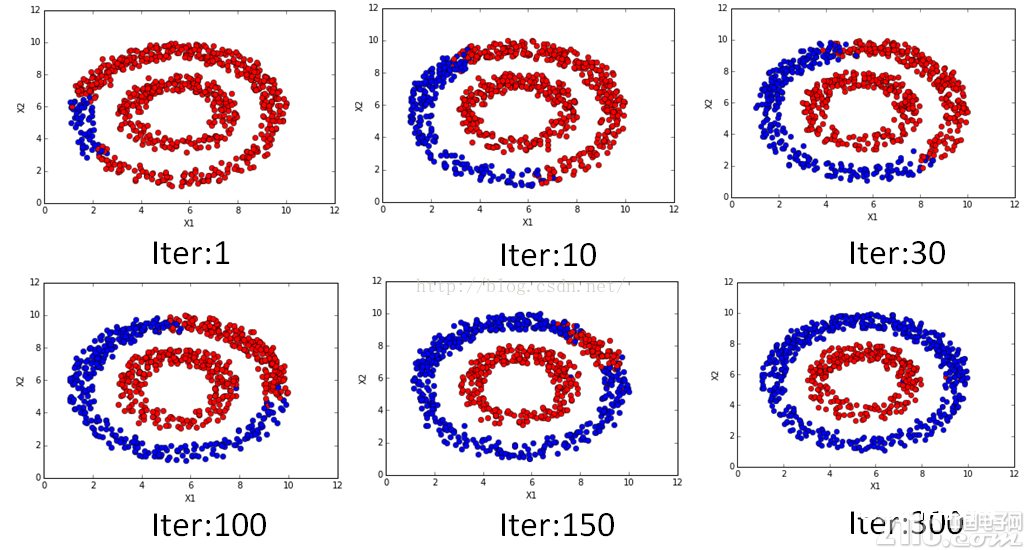
是不是很漂亮的传达进程?!在数值上也是能够看到跟着迭代的进行逐步收敛的,迭代的数值改变进程如下:
—> Iteration 0/400, changed: 1602.000000
—> Iteration 1/400, changed: 6.300182
—> Iteration 2/400, changed: 5.129996
—> Iteration 3/400, changed: 4.301994
—> Iteration 4/400, changed: 3.819295
—> Iteration 5/400, changed: 3.501743
—> Iteration 6/400, changed: 3.277122
—> Iteration 7/400, changed: 3.105952
—> Iteration 8/400, changed: 2.967030
—> Iteration 9/400, changed: 2.848606
—> Iteration 10/400, changed: 2.743997
—> Iteration 11/400, changed: 2.649270
—> Iteration 12/400, changed: 2.562057
—> Iteration 13/400, changed: 2.480885
—> Iteration 14/400, changed: 2.404774
—> Iteration 15/400, changed: 2.333075
—> Iteration 16/400, changed: 2.265301
—> Iteration 17/400, changed: 2.201107
—> Iteration 18/400, changed: 2.140209
—> Iteration 19/400, changed: 2.082354
—> Iteration 20/400, changed: 2.027376
—> Iteration 21/400, changed: 1.975071
—> Iteration 22/400, changed: 1.925286
—> Iteration 23/400, changed: 1.877894
—> Iteration 24/400, changed: 1.832743
—> Iteration 25/400, changed: 1.789721
—> Iteration 26/400, changed: 1.748706
—> Iteration 27/400, changed: 1.709593
—> Iteration 28/400, changed: 1.672284
—> Iteration 29/400, changed: 1.636668
—> Iteration 30/400, changed: 1.602668
—> Iteration 31/400, changed: 1.570200
—> Iteration 32/400, changed: 1.539179
—> Iteration 33/400, changed: 1.509530
—> Iteration 34/400, changed: 1.481182
—> Iteration 35/400, changed: 1.454066
—> Iteration 36/400, changed: 1.428120
—> Iteration 37/400, changed: 1.403283
—> Iteration 38/400, changed: 1.379502
—> Iteration 39/400, changed: 1.356734
—> Iteration 40/400, changed: 1.334906
—> Iteration 41/400, changed: 1.313983
—> Iteration 42/400, changed: 1.293921
—> Iteration 43/400, changed: 1.274681
—> Iteration 44/400, changed: 1.256214
—> Iteration 45/400, changed: 1.238491
—> Iteration 46/400, changed: 1.221474
—> Iteration 47/400, changed: 1.205126
—> Iteration 48/400, changed: 1.189417
—> Iteration 49/400, changed: 1.174316
—> Iteration 50/400, changed: 1.159804
—> Iteration 51/400, changed: 1.145844
—> Iteration 52/400, changed: 1.132414
—> Iteration 53/400, changed: 1.119490
—> Iteration 54/400, changed: 1.107032
—> Iteration 55/400, changed: 1.095054
—> Iteration 56/400, changed: 1.083513
—> Iteration 57/400, changed: 1.072397
—> Iteration 58/400, changed: 1.061671
—> Iteration 59/400, changed: 1.051324
—> Iteration 60/400, changed: 1.041363
—> Iteration 61/400, changed: 1.031742
—> Iteration 62/400, changed: 1.022459
—> Iteration 63/400, changed: 1.013494
—> Iteration 64/400, changed: 1.004836
—> Iteration 65/400, changed: 0.996484
—> Iteration 66/400, changed: 0.988407
—> Iteration 67/400, changed: 0.980592
—> Iteration 68/400, changed: 0.973045
—> Iteration 69/400, changed: 0.965744
—> Iteration 70/400, changed: 0.958682
—> Iteration 71/400, changed: 0.951848
—> Iteration 72/400, changed: 0.945227
—> Iteration 73/400, changed: 0.938820
—> Iteration 74/400, changed: 0.932608
—> Iteration 75/400, changed: 0.926590
—> Iteration 76/400, changed: 0.920765
—> Iteration 77/400, changed: 0.915107
—> Iteration 78/400, changed: 0.909628
—> Iteration 79/400, changed: 0.904309
—> Iteration 80/400, changed: 0.899143
—> Iteration 81/400, changed: 0.894122
—> Iteration 82/400, changed: 0.889259
—> Iteration 83/400, changed: 0.884530
—> Iteration 84/400, changed: 0.879933
—> Iteration 85/400, changed: 0.875464
—> Iteration 86/400, changed: 0.871121
—> Iteration 87/400, changed: 0.866888
—> Iteration 88/400, changed: 0.862773
—> Iteration 89/400, changed: 0.858783
—> Iteration 90/400, changed: 0.854879
—> Iteration 91/400, changed: 0.851084
—> Iteration 92/400, changed: 0.847382
—> Iteration 93/400, changed: 0.843779
—> Iteration 94/400, changed: 0.840274
—> Iteration 95/400, changed: 0.836842
—> Iteration 96/400, changed: 0.833501
—> Iteration 97/400, changed: 0.830240
—> Iteration 98/400, changed: 0.827051
—> Iteration 99/400, changed: 0.823950
—> Iteration 100/400, changed: 0.820906
—> Iteration 101/400, changed: 0.817946
—> Iteration 102/400, changed: 0.815053
—> Iteration 103/400, changed: 0.812217
—> Iteration 104/400, changed: 0.809437
—> Iteration 105/400, changed: 0.806724
—> Iteration 106/400, changed: 0.804076
—> Iteration 107/400, changed: 0.801480
—> Iteration 108/400, changed: 0.798937
—> Iteration 109/400, changed: 0.796448
—> Iteration 110/400, changed: 0.794008
—> Iteration 111/400, changed: 0.791612
—> Iteration 112/400, changed: 0.789282
—> Iteration 113/400, changed: 0.786984
—> Iteration 114/400, changed: 0.784728
—> Iteration 115/400, changed: 0.782516
—> Iteration 116/400, changed: 0.780355
—> Iteration 117/400, changed: 0.778216
—> Iteration 118/400, changed: 0.776139
—> Iteration 119/400, changed: 0.774087
—> Iteration 120/400, changed: 0.772072
—> Iteration 121/400, changed: 0.770085
—> Iteration 122/400, changed: 0.768146
—> Iteration 123/400, changed: 0.766232
—> Iteration 124/400, changed: 0.764356
—> Iteration 125/400, changed: 0.762504
—> Iteration 126/400, changed: 0.760685
—> Iteration 127/400, changed: 0.758889
—> Iteration 128/400, changed: 0.757135
—> Iteration 129/400, changed: 0.755406
四、LP算法MPI并行完成
这儿,咱们测验的是LP的变身版别。从公式,咱们能够看到,第二项PULYL迭代进程并没有发生改变,所以这部分实践上从迭代开端就能够核算好,然后防止重复核算。不过,不管怎样,LP算法都要核算一个UxU的矩阵PUU和一个UxC矩阵FU的乘积。当咱们的unlabeled数据十分多,并且类别也许多的时分,核算是很慢的,一起占用的内存量也十分大。别的,结构Graph需求核算两两的类似度,也是O(n2)的复杂度,当咱们数据的特征维度很大的时分,这个核算量也是十分客观的。所以咱们就得考虑并行处理了。并且最好是能放到集群上并行。那怎么并行呢?
对算法的并行化,一般分为两种:数据并行和模型并行。
数据并行很好了解,便是将数据区分,每个节点只处理一部分数据,例如咱们结构图的时分,核算每个数据的k近邻。例如咱们有1000个样本和20个CPU节点,那么就均匀分发,让每个CPU节点核算50个样本的k近邻,然后终究再兼并咱们的成果。可见这个加快比也是十分可观的。
模型并行一般发生在模型很大,无法放到单机的内存里边的时分。例如巨大的深度神经网络练习的时分,就需求把这个网络切开,然后别离求解梯度,终究有个leader的节点来搜集咱们的梯度,再反馈给咱们去更新。当然了,其间存在更细致和高效的工程处理办法。在咱们的LP算法中,也是能够做模型并行的。假设咱们的类别数C很大,把类别数切开,让不同的CPU节点处理,实践上就相当于模型并行了。
那为啥不切大矩阵PUU,而是切小点的矩阵FU,由于大矩阵PUU无法独立分块,并行的一个原则是处理有必要是独立的。 矩阵FU依靠的是一切的U,而把PUU切开分发到其他节点的时分,每次FU的更新都需求和其他的节点通讯,这个通讯的价值是很大的(实践上,许多并行体系无法到达线性的加快度的瓶颈是通讯!线性加快比是,我增加了n台机器,速度就提高了n倍)。可是对类别C也便是矩阵FU切分,就不会有这个问题,由于他们的核算是独立的。仅仅决议样本的终究类别的时分,将一切的FU搜集回来求max就能够了。
所以,鄙人面的代码中,是一起包括了数据并行和模型并行的雏形的。别的,还值得一提的是,咱们是迭代算法,那决议什么时分迭代算法中止?除了判别收敛外,咱们还能够让每迭代几步,就用测验label测验一次成果,看模型的全体练习功能怎么。特别是判别练习是否过拟合的时分十分有用。因而,代码中包括了这部分内容。
好了,代码总算来了。咱们能够搞点大数据库来测验,假设有MPI集群条件的话就更好了。
下面的代码依靠numpy、scipy(用其稀少矩阵加快核算)和mpi4py。其间mpi4py需求依靠openmpi和Cpython,能够参阅我之前的博客进行装置。
#***************************************************************************
#*
#* Description: label propagation
#* Author: Zou Xiaoyi (zouxy09@qq.com)
#* Date: 2015-10-15
#* HomePage: http://blog.csdn.net/zouxy09
#*
#**************************************************************************
import os, sys, time
import numpy as np
from scipy.sparse import csr_matrix, lil_matrix, eye
import operator
import cPickle as pickle
import mpi4py.MPI as MPI
#
# Global variables for MPI
#
# instance for invoking MPI related functions
comm = MPI.COMM_WORLD
# the node rank in the whole community
comm_rank = comm.Get_rank()
# the size of the whole community, i.e., the total number of working nodes in the MPI cluster
comm_size = comm.Get_size()
# load mnist dataset
def load_MNIST():
import gzip
f = gzip.open(mnist.pkl.gz, rb)
train, val, test = pickle.load(f)
f.close()
Mat_Label = train[0]
labels = train[1]
Mat_Unlabel = test[0]
groundtruth = test[1]
labels_id = [0, 1, 2, 3, 4, 5, 6, 7, 8, 9]
return Mat_Label, labels, labels_id, Mat_Unlabel, groundtruth
# return k neighbors index
def navie_knn(dataSet, query, k):
numSamples = dataSet.shape[0]
## step 1: calculate Euclidean distance
diff = np.tile(query, (numSamples, 1)) – dataSet
squaredDiff = diff ** 2
squaredDist = np.sum(squaredDiff, axis = 1) # sum is performed by row
## step 2: sort the distance
sortedDistIndices = np.argsort(squaredDist)
if k > len(sortedDistIndices):
k = len(sortedDistIndices)
return sortedDistIndices[0:k]
# build a big graph (normalized weight matrix)
# sparse U x (U + L) matrix
def buildSubGraph(Mat_Label, Mat_Unlabel, knn_num_neighbors):
num_unlabel_samples = Mat_Unlabel.shape[0]
data = []; indices = []; indptr = [0]
Mat_all = np.vstack((Mat_Label, Mat_Unlabel))
values = np.ones(knn_num_neighbors, np.float32) / knn_num_neighbors
for i in xrange(num_unlabel_samples):
k_neighbors = navie_knn(Mat_all, Mat_Unlabel[i, :], knn_num_neighbors)
indptr.append(np.int32(indptr[-1]) + knn_num_neighbors)
indices.extend(k_neighbors)
data.append(values)
return csr_matrix((np.hstack(data), indices, indptr))
# build a big graph (normalized weight matrix)
# sparse U x (U + L) matrix
def buildSubGraph_MPI(Mat_Label, Mat_Unlabel, knn_num_neighbors):
num_unlabel_samples = Mat_Unlabel.shape[0]
local_data = []; local_indices = []; local_indptr = [0]
Mat_all = np.vstack((Mat_Label, Mat_Unlabel))
values = np.ones(knn_num_neighbors, np.float32) / knn_num_neighbors
sample_offset = np.linspace(0, num_unlabel_samples, comm_size + 1).astype(‘int’)
for i in range(sample_offset[comm_rank], sample_offset[comm_rank+1]):
k_neighbors = navie_knn(Mat_all, Mat_Unlabel[i, :], knn_num_neighbors)
local_indptr.append(np.int32(local_indptr[-1]) + knn_num_neighbors)
local_indices.extend(k_neighbors)
local_data.append(values)
data = np.hstack(comm.allgather(local_data))
indices = np.hstack(comm.allgather(local_indices))
indptr_tmp = comm.allgather(local_indptr)
indptr = []
for i in range(len(indptr_tmp)):
if i == 0:
indptr.extend(indptr_tmp[i])
else:
last_indptr = indptr[-1]
del(indptr[-1])
indptr.extend(indptr_tmp[i] + last_indptr)
return csr_matrix((np.hstack(data), indices, indptr), dtype = np.float32)
# label propagation
def run_label_propagation_sparse(knn_num_neighbors = 20, max_iter = 100, tol = 1e-4, test_per_iter = 1):
# load data and graph
print Processor %d/%d loading graph file… % (comm_rank, comm_size)
#Mat_Label, labels, Mat_Unlabel, groundtruth = loadFourBandData()
Mat_Label, labels, labels_id, Mat_Unlabel, unlabel_data_id = load_MNIST()
if comm_size > len(labels_id):
raise ValueError(Sorry, the processors must be less than the number of classes)
#affinity_matrix = buildSubGraph(Mat_Label, Mat_Unlabel, knn_num_neighbors)
affinity_matrix = buildSubGraph_MPI(Mat_Label, Mat_Unlabel, knn_num_neighbors)
# get some parameters
num_classes = len(labels_id)
num_label_samples = len(labels)
num_unlabel_samples = Mat_Unlabel.shape[0]
affinity_matrix_UL = affinity_matrix[:, 0:num_label_samples]
affinity_matrix_UU = affinity_matrix[:, num_label_samples:num_label_samples+num_unlabel_samples]
if comm_rank == 0:
print Have %d labeled images, %d unlabeled images and %d classes % (num_label_samples, num_unlabel_samples, num_classes)
# divide label_function_U and label_function_L to all processors
class_offset = np.linspace(0, num_classes, comm_size + 1).astype(‘int’)
# initialize local label_function_U
local_start_class = class_offset[comm_rank]
local_num_classes = class_offset[comm_rank+1] – local_start_class
local_label_function_U = eye(num_unlabel_samples, local_num_classes, 0, np.float32, format=’csr’)
# initialize local label_function_L
local_label_function_L = lil_matrix((num_label_samples, local_num_classes), dtype = np.float32)
for i in xrange(num_label_samples):
class_off = int(labels[i]) – local_start_class
if class_off >= 0 and class_off local_num_classes:
local_label_function_L[i, class_off] = 1.0
local_label_function_L = local_label_function_L.tocsr()
local_label_info = affinity_matrix_UL.dot(local_label_function_L)
print Processor %d/%d has to process %d classes… % (comm_rank, comm_size, local_label_function_L.shape[1])
# start to propagation
iter = 1; changed = 100.0;
evaluation(num_unlabel_samples, local_start_class, local_label_function_U, unlabel_data_id, labels_id)
while True:
pre_label_function = local_label_function_U.copy()
# propagation
local_label_function_U = affinity_matrix_UU.dot(local_label_function_U) + local_label_info
# check converge
local_changed = abs(pre_label_function – local_label_function_U).sum()
changed = comm.reduce(local_changed, root = 0, op = MPI.SUM)
status = ‘RUN’
test = False
if comm_rank == 0:
if iter % 1 == 0:
norm_changed = changed / (num_unlabel_samples * num_classes)
print —> Iteration %d/%d, changed: %f % (iter, max_iter, norm_changed)
if iter >= max_iter or changed tol:
status = ‘STOP’
print ************** Iteration over! ****************
if iter % test_per_iter == 0:
test = True
iter += 1
test = comm.bcast(test if comm_rank == 0 else None, root = 0)
status = comm.bcast(status if comm_rank == 0 else None, root = 0)
if status == ‘STOP’:
break
if test == True:
evaluation(num_unlabel_samples, local_start_class, local_label_function_U, unlabel_data_id, labels_id)
evaluation(num_unlabel_samples, local_start_class, local_label_function_U, unlabel_data_id, labels_id)
def evaluation(num_unlabel_samples, local_start_class, local_label_function_U, unlabel_data_id, labels_id):
# get local label with max score
if comm_rank == 0:
print Start to combine local result…
local_max_score = np.zeros((num_unlabel_samples, 1), np.float32)
local_max_label = np.zeros((num_unlabel_samples, 1), np.int32)
for i in xrange(num_unlabel_samples):
local_max_label[i, 0] = np.argmax(local_label_function_U.getrow(i).todense())
local_max_score[i, 0] = local_label_function_U[i, local_max_label[i, 0]]
local_max_label[i, 0] += local_start_class
# gather the results from all the processors
if comm_rank == 0:
print Start to gather results from all processors
all_max_label = np.hstack(comm.allgather(local_max_label))
all_max_score = np.hstack(comm.allgather(local_max_score))
# get terminate label of unlabeled data
if comm_rank == 0:
print Start to analysis the results…
right_predict_count = 0
for i in xrange(num_unlabel_samples):
if i % 1000 == 0:
print ***, all_max_score[i]
max_idx = np.argmax(all_max_score[i])
max_label = all_max_label[i, max_idx]
if int(unlabel_data_id[i]) == int(labels_id[max_label]):
right_predict_count += 1
accuracy = float(right_predict_count) * 100.0 / num_unlabel_samples
print Have %d samples, accuracy: %.3f%%! % (num_unlabel_samples, accuracy)
if __name__ == ‘__main__’:
run_label_propagation_sparse(knn_num_neighbors = 20, max_iter = 30)



